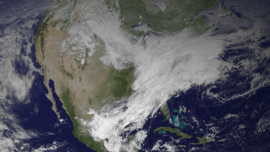2013–14 North American cold wave

A GOES 13 satellite image of a strong winter storm on January 2, 2014.
|
|
| Formed | January 2, 2014 |
|---|---|
| Dissipated | Late April 2014 |
| Lowest pressure | 939 mb (27.7 inHg) (January 8, 2014 system) |
| Damage | $5 billion (United States) |
| Areas affected |
Canada Central United States Eastern United States Northern Mexico |
| Part of the 2013–14 North American winter | |
The 2014 North American cold wave was an extreme weather event that extended through the late winter months of the 2013–2014 winter season, and was also part of an unusually cold winter affecting parts of Canada and parts of the north-central and upper eastern United States. The event occurred in early 2014 and was caused by a southward shift of the North Polar Vortex. Record-low temperatures also extended well into March.
On January 2, an Arctic cold front initially associated with a nor'easter tracked across Canada and the United States, resulting in heavy snowfall. Temperatures fell to unprecedented levels, and low temperature records were broken across the United States. Business, school, and road closures were common, as well as mass flight cancellations. Altogether, more than 200 million people were affected, in an area ranging from the Rocky Mountains to the Atlantic Ocean and extending south to include roughly 187 million residents of the Continental United States.
Beginning on January 2, 2014, sudden stratospheric warming (SSW) led to the breakdown of the semi-permanent feature across the Arctic known as the polar vortex. Without an active upper-level vortex to keep frigid air bottled up across the Arctic, the cold air mass was forced southward as upper-level warming displaced the jet stream. With extensive snow-cover across Canada and Siberia, Arctic air had no trouble remaining extremely cold as it was forced southward into the United States.
According to the UK Met Office, the jet stream deviated to the south (bringing cold air with it) as a result of unusual contrast between cold air in Canada and mild winter temperatures in the United States. This produced significant wind where the air masses met, leading to bitter wind chills and worsening the impacts of the record cold temperatures.
On January 5, 2014, Green Bay, Wisconsin was −18 °F (−28 °C). The previous record low for this day was set in 1979.
On January 6, 2014, Babbitt, Minnesota was the coldest place in the country at −37 °F (−38 °C). The cold air reached as far as Dallas, which experienced a low temperature of 16 °F (−9 °C).
...
Wikipedia
